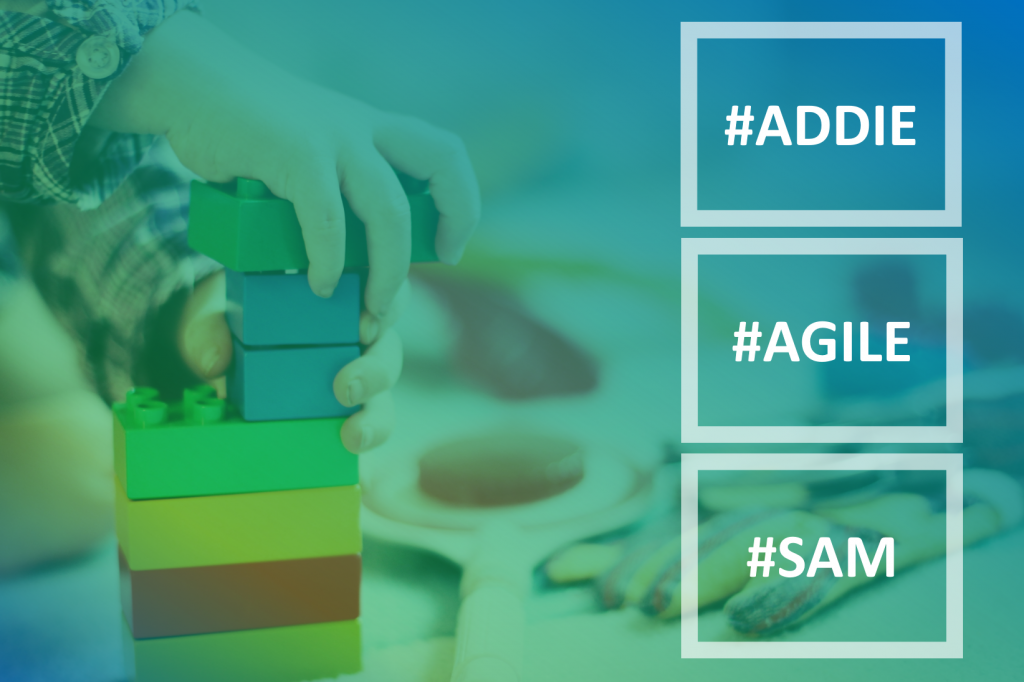Learning methodologies can be complex and boring. But in case you are explaining them to a client, much of the complexity can be avoided.
If you opened this article hoping to convince your client by giving them a jargon-less overview of the top 3 popular eLearning development methodologies – ADDIE, AGILE, and SAM over a coffee, you got just what you wanted.
Larry, Curly, Moe and … Building Blocks?
Any training development comes down to following a standard set of tasks that define the efficiency and quality of the learning outcome. We call these standards as learning methodologies. Over the years, these standards have evolved to form three main strategies:
ADDIE (Analyze, Design, Develop Implement, Evaluate)
AGILE
SAM (Successive Approximation Model)
Instead of directly talking about the differences between these methodologies, we will talk about Larry, Curly and Moe who wish to construct a Lego building for their school project.
The first building: ADDIE
Larry chooses ADDIE approach to build his skyscraper.
- Analysis: He gets the inputs from his teacher about the number of storeys, windows, and doors.
- Design: He creates the floor plan and gets it approved by his teacher.
- Development: He buys Lego blocks from the store, skips his favorite cartoon show and constructs the building before his bedtime.
- Implementation: He carefully wraps his project and takes it to school for submission.
- Evaluation: His teacher checks the Lego building against the approved design, and gives Larry an A+. All is good.
But what if Larry’s teacher suggests the ground floor should have an additional window and a wider door? Larry will have to skip the cartoon show again and redo the complete construction. Pretty tedious, right?
A smarter approach: AGILE
Curly anticipates that his teacher may suggest some changes. He chooses the AGILE approach:
- Curly makes a list of all the key features that his teacher mentions and builds a prototype.
- He then shows the prototype to his teacher, who suggests some changes.
- Curly incorporates those changes and submits it again for the review.
- He repeats the steps 2 & 3 till his teacher signs-off.
- Curly then happily submits the building for the final evaluation. Success!
In real life, we use fancier and complex jargon such as Sprints, Scrums and Product Backlogs to describe these stages, but the core idea is the same.
But, what if the teacher suggests some new changes every time Curly shows his progress? This will create an unending loop of review and rework.
An even better approach: SAM
Moe decides to use Curly’s approach but limits it to three reviews and three reworks. This makes his teacher happy as well as saves his lunchtime.
- Moe collects all the necessary inputs.
- He builds one-third of the building and shows it to his teacher.
- Moe’s teacher suggests some changes in the design. He also gives further inputs on the next phase of development.
- Moe reworks based on his teacher’s suggestions, works on the next part and submits the building for review; now, two-thirds of the work is complete.
- He repeats the last step once more and then finally submits his project for examination.
In real life, the number of review stages may scale up to 8 iterations depending on the project size and complexity. But the main idea remains pretty much the same.
Which approach is better for eLearning Development?
Although it largely depends on the scenarios, Moe adopted a smarter approach:
- Limiting the number of iterative reviews
- Incorporating feedback and suggestions at every stage
- The final version of the building is pretty much what the teacher expected, comparatively with lesser reviews.
Now, you know how to explain ADDIE, AGILE and SAM to your client and your coffee is almost finished. Get a refill if you want to think about it.
This post is re-shared from my original post.

Great post! After reading your post I came to know the difference of Agile vs ADDIE. Thanks for sharing such a great knowledge.Keep posting.